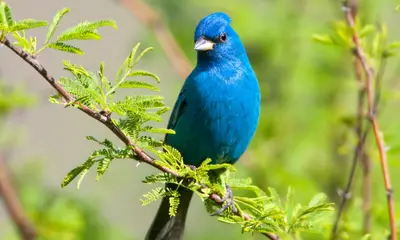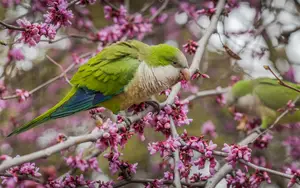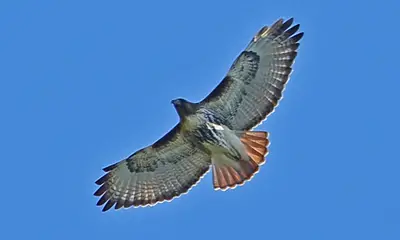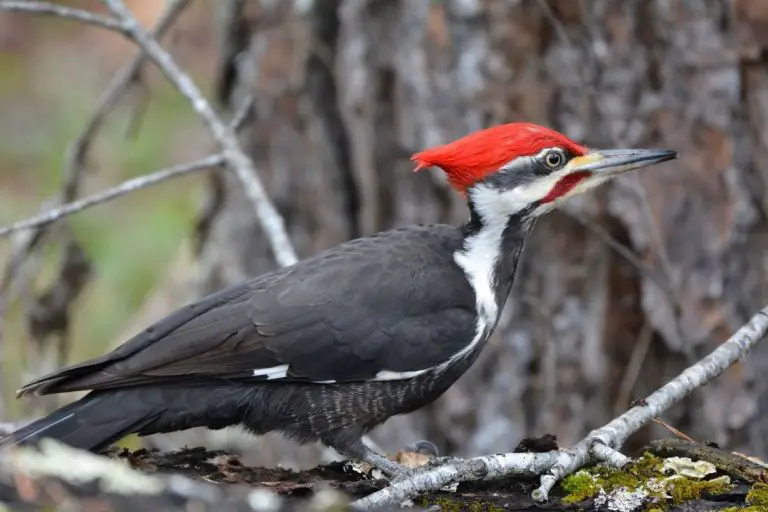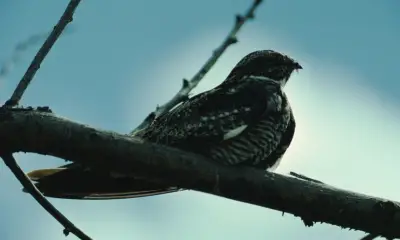15 Amazing BLACK Birds With WHITE SPOTS (Photos & Key Facts)
Did you spot a black bird with white spots? In that case you’ll probably want to know what species you saw.
To help you identify the bird you spotted, we’ll cover the most common types of black birds that have white spots in this article.
We’ll show you how to identify these birds, and will also cover the key facts to know about each species.

What are the types of black birds with white spots?
The 15 most common black-colored birds with white spots are:
- Common Starling
- Downy Woodpecker
- Black-and-white Warbler
- Spotted Towhee
- Hairy Woodpecker
- Yellow-bellied Sapsucker
- Lark Bunting
- Tricolored Blackbird
- Common Loon
- Anhinga
- California Quail
- Guinea Fowl
- Asian Koel
- Red-and-yellow Barbet
While many of these birds are found in North America, we also included some that hail from other parts of the world.
Now let’s dive into the details, and take a closer look at each of these species in order to get the full scoop:
Common Starling (European Starling)
Scientific name: Sturnus vulgaris
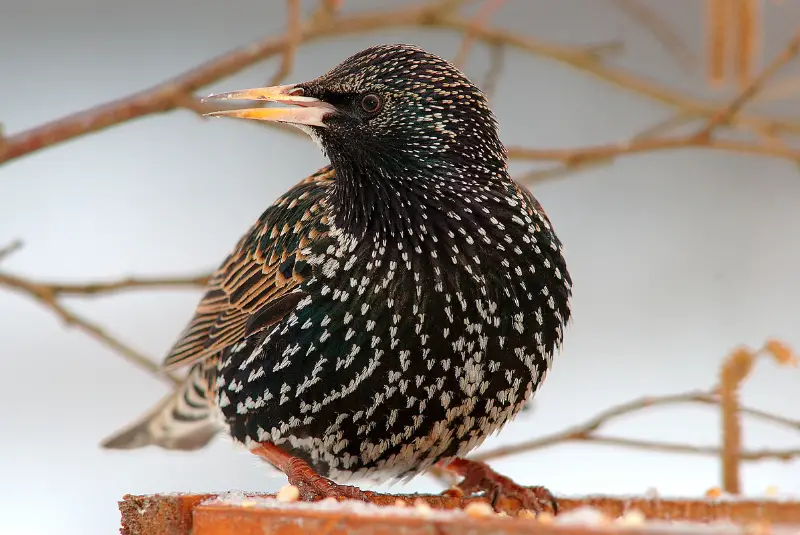
The Common Starling is the most common black-colored bird with white spots. However, it’s important to note that starlings are only covered by white spots in winter.
In summer they are uniformly black with a glossy sheen, and so look superficially similar to many blackbirds.
This bird is originally from Europe, Asia, and North Africa, but it was introduced to North America and many other parts of the world, where it has established itself as a successful breeding species within a short period of time.
European Starlings inhabit open country with few trees as their original habitat, but they are also among the most successful urban birds, and are especially common in parks and gardens.
While European Starlings nest in tree holes in the wild, they are also known to nest inside buildings and nest boxes in urban settings.
Unfortunately, native birds are sometimes driven out of their nesting sites by competing Starlings.
Similar to grackles and other blackbirds, European Starlings form large flocks outside of the nesting season.
These flocks can contain more than a million birds, and can be seen performing amazing aerial acrobatics.
Downy Woodpecker
Scientific name: Picoides pubescens

The Downy Woodpecker is the smallest woodpecker found in North America.
While males are black and white with a small red patch on their nape, females are entirely black and white.
The wings of both sexes are black with white bars, which look like spots when the wings are folded.
Downy Woodpeckers are non-migratory, and can be seen all year round throughout North America, except for the arid regions in southern states.
You can tell this bird apart from the Hairy Woodpecker by its smaller size and short bill.
While Downy Woodpeckers don’t migrate, they like to move around outside of the breeding season, in search of areas with plentiful food.
Their preferred habitat is deciduous or mixed forest, where they feed on insects and insect larvae found under the bark of trees. During winter they also eat berries and seeds.
Black-and-white Warbler
Scientific name: Mniotilta varia
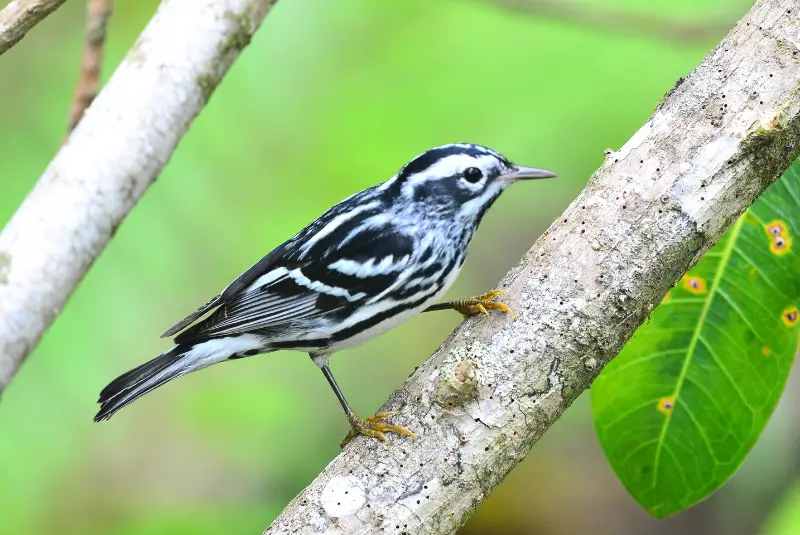
The Black-and-white Warbler has black upperparts with white stripes, as well as black wings with white wing bars. When the wings are folded, the stripes look more like spots of white.
Unlike many other warblers, female Black-and-white Warblers look very similar to the males, except for lacking the black patch behind and below their eye, which increases the white area on their head.
The Black-and-white Warbler is a breeding bird in the eastern parts of North America, where it can be found from May to August from Canada in the north to Texas in the south.
This bird is a seasonal migrant that spends the winter in Central America, with a small percentage of its population wintering in Florida and the Gulf Coast.
It can be found in a range of diverse forest habitats, and feeds on small insects and other invertebrates.
Spotted Towhee
Scientific name: Pipilo maculatus
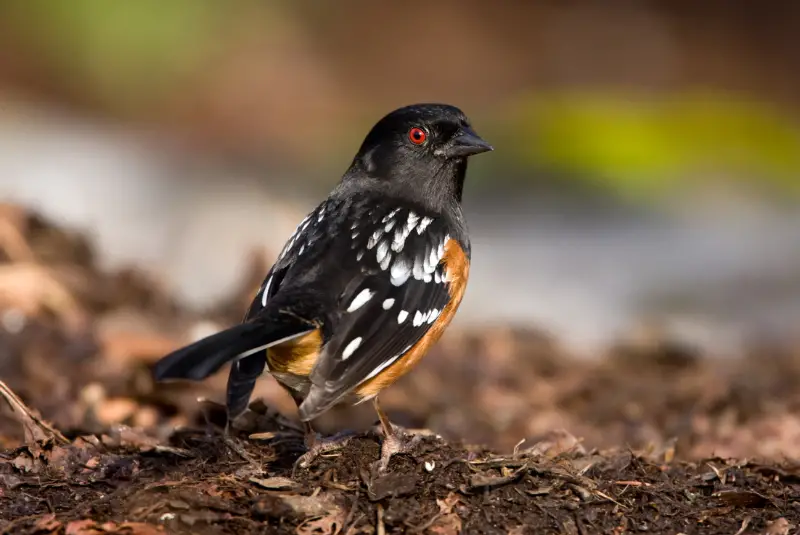
The Spotted Towhee is a songbird of the western USA, where it is a migratory bird in the northern part of its range, and a year-round resident in the southern part.
Male and female Spotted Towhees look similar and have a black hood and black upperparts that are marked with white dots.
Their flanks are reddish orange, their belly is white, and their eyes are red. The long tail is entirely black.
As already mentioned, this bird is a year-round resident in the southern and western part of its range, while northern and eastern birds migrate south in winter.
The migratory part of the population has a winter range that extends southwards towards Mexico.
Hairy Woodpecker
Scientific name: Picoides villosus

The Hairy Woodpecker looks similar to the Downy Woodpecker, but has a longer, thicker bill, and is a much larger bird overall.
Both the male and the female have black upperparts with white bars on the wing feathers, which look like spots when the wings are folded.
The male has a very small red patch on the back of its head, which is considerably smaller than the red patches on other woodpecker species.
The Hairy Woodpecker is a common breeding bird found throughout North America, and is a year-round resident.
This woodpecker breeds in both coniferous and deciduous forests, and is even found in parks and other urban areas with trees.
Yellow-bellied Sapsucker
Scientific name: Sphyrapicus varius
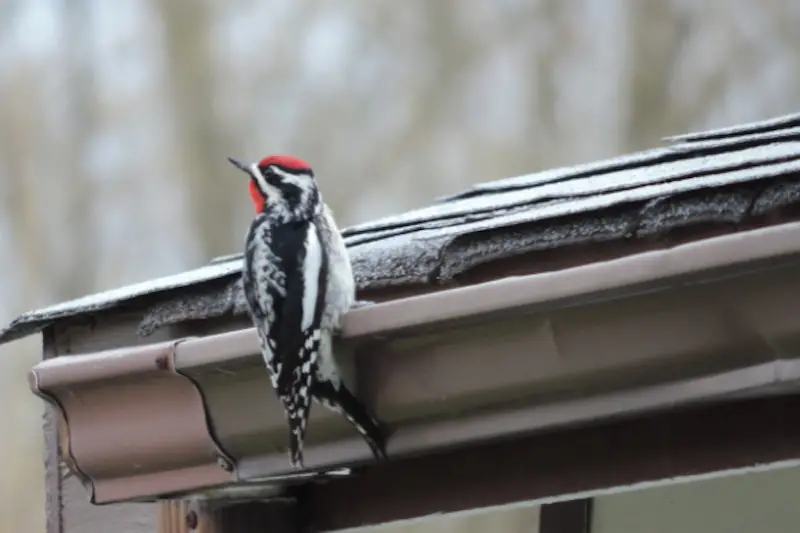
The Yellow-bellied Sapsucker is a winter visitor in Illinois that can be seen on migration in the northern part of Illinois, and wintering in the southern part.
The male has a checkered back with a scarlet red crown, forehead, and chin. It also has a yellowish tinge on its belly and chest. The female looks similar to the male, but has a white chin.
The Yellow-bellied Sapsucker is found in small forests, as well as rural and suburban areas.
This bird drills holes into trees in order to drink the sap that oozes out, which it. The bleeding sap also attracts insects, which the Yellow-bellied Sapsucker feeds on.
Lark Bunting
Scientific name: Calamospiza melanocorys
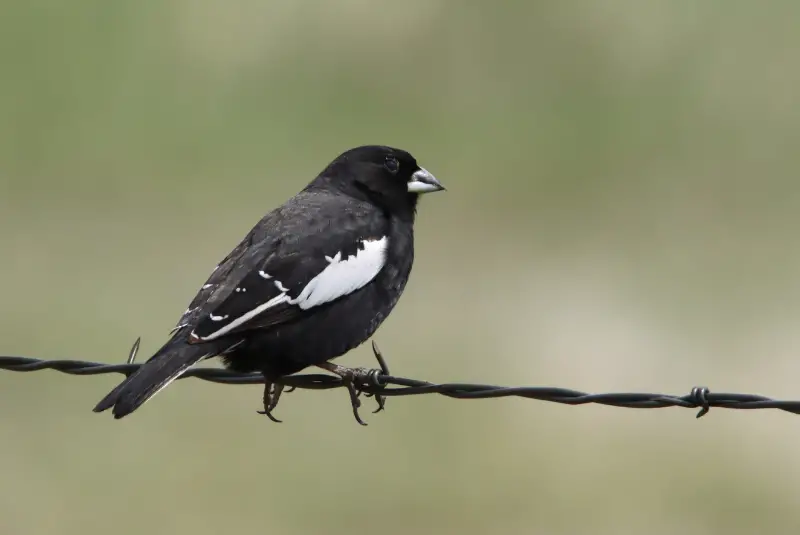
The Lark Bunting is a medium sized songbird with striking black-and-white coloration in the male.
Male Lark Buntings are entirely black with a bright white patch on their wings. The females and juveniles, on the other hand, are pale brown with white streaks.
The Lark Bunting is a summer visitor in the central part of North America, with a range that extends northwards up to Canada.
During the fall, it forms large flocks that migrate south together. It winters in Mexico and the southern United States.
The preferred habitat of the Lark Bunting are prairies and grassland, where it forages for seeds and small invertebrates during summer.
Tricolored Blackbird
Scientific name: Agelaius tricolor
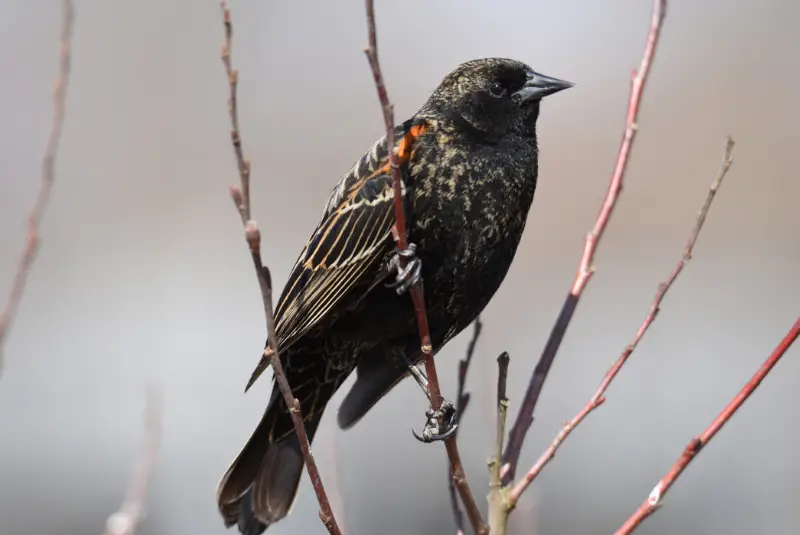
Male Tricolored Blackbirds look superficially similar to Red-winged Blackbirds. Their whole body is iridescent black, except for a red shoulder patch with a white streak underneath.
They can be distinguished from Red-winged Blackbirds by virtue of their smaller red shoulder patch, as well as the broader white line underneath it.
Tricolored Blackbirds used to be very common in California, with flocks that numbered in the millions.
However, due to the extensive destruction of coastal swamps and marshes, they are now an endangered species, with less than forty thousand adults accounting for the entire California population.
Fortunately, Tricolored Blackbirds have started breeding in agricultural areas in addition to marshes, which means there is hope for the survival of this species.
Common Loon
Scientific name: Gavia immer
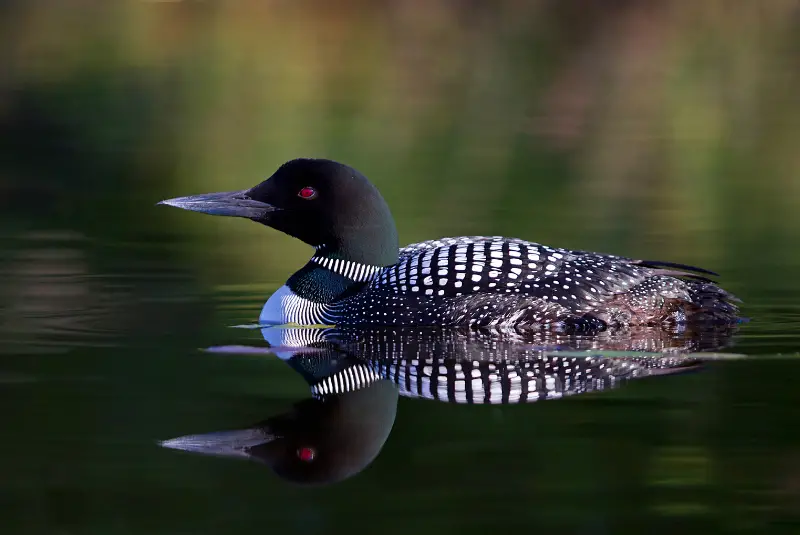
If you spotted a black waterbird with white dots, it is most likely the Common Loon (also known as the Great Northern Diver).
These waterbirds are native to North America and have large rounded heads with sharp beaks that resemble a dagger.
In the summer months, the birds have black heads, white chests, and lots of white spots on their black-colored plumage. In the winter or autumn months, their color dulls and turns into a pale gray.
The common loon is a fantastic diver and is super stealthy when it hunts underwater, allowing it to sneak up on fish without even a splash. It can dive to depths of up to two-hundred fifty feet.
To top that off, these birds can stay submerged for up to five minutes and even swallow their prey while they are still underwater.
They have a wingspan of between forty and fifty inches and can live for up to thirty years of age.
Anhinga
Scientific name: Anhinga anhinga
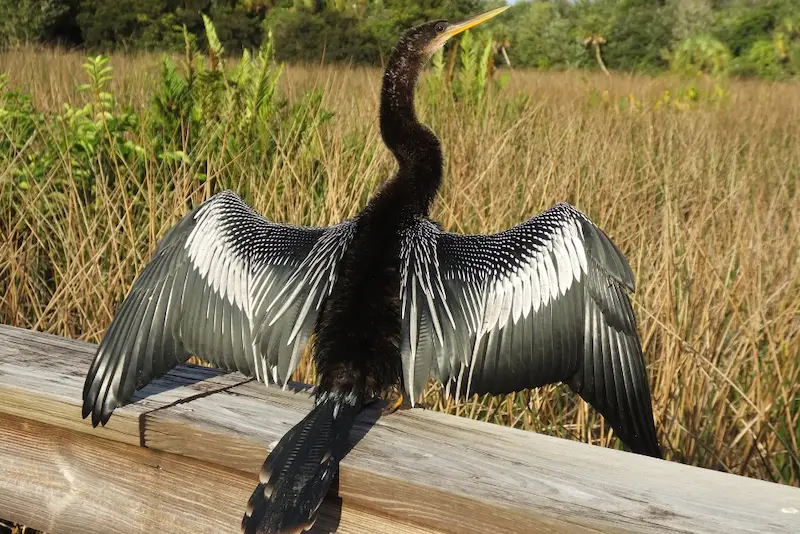
The Anhinga looks similar to a cormorant, but has a snake-like neck, which it uses to catch fish underwater.
When this bird is in the water, it’s common to see only the head and neck protruding above the water surface.
Adult male Anhingas are largely black, while females have a black body with a dark brown head and neck.
Both sexes have white markings on their wings that look like white speckles when the wings are folded.
It lives in swamps and freshwater ponds, and is a year-round resident in the southern part of its North American range.
California Quail
Scientific name: Callipepla californica

The California Quail is the state bird of California and is also known as the California Valley Quail.
This small bird is a ground dweller, which means it spends a significant amount of time on the ground as opposed to flying.
California Quails are dark gray and black with white spots and streaks, which make them stand out amongst other birds.
This little bird is known for its showy crest which is usually black for the males and brown for the females.
Despite having wings and the ability to fly, these birds are excellent runners and can even reach speeds of twelve miles per hour.
They are extremely social birds and like to stay in groups. One advantage of this is that they will have many eyes looking out for predators which in turn keeps them safer.
These birds are omnivorous and for the most part enjoy feeding on seeds, acorns, berries, leaves, flowers, bulbs, and insects.
Guineafowl
Scientific name: Numida meleagris
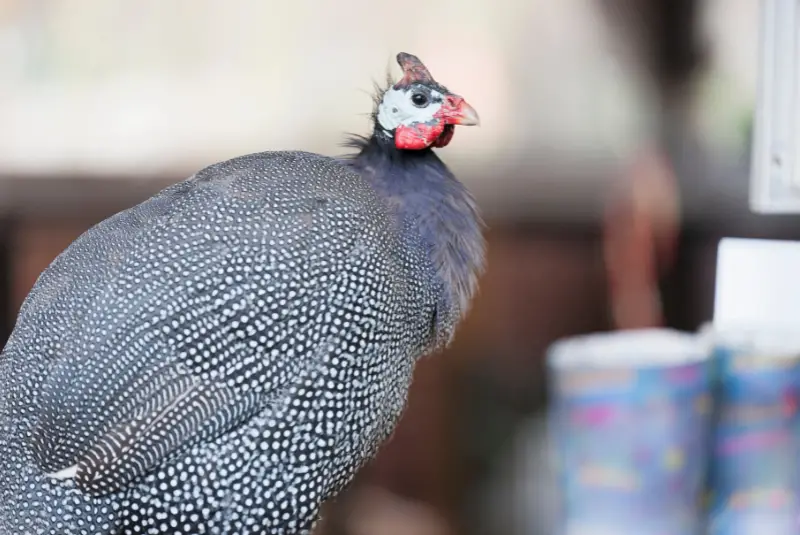
The Guineafowl is originally from Sub-Saharan Africa, but is now kept as an ornamental bird in many parts of the world.
The body plumage is dark blackish gray with small white dots scattered all over it.
It can also be recognized by the helmet-like casque on the head, as well as a red wattle and blue skin on the neck.
Guineafowl forage in groups of up to 25 birds, and alert each other to danger with a loud call.
Similar to most ground birds, Guinea Fowl prefer to evade predators on foot, but will burst into flight if necessary.
Asian Koel
Scientific name: Eudynamys scolopaceus
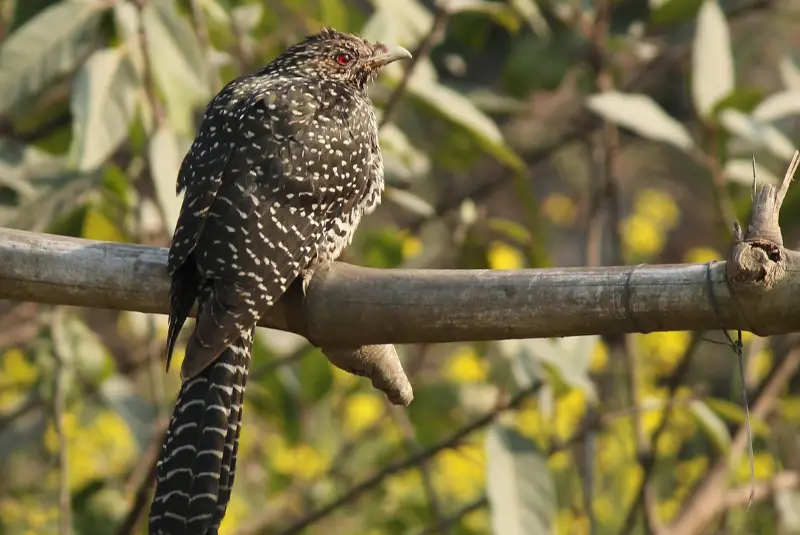
The Asian Koel belongs to the family of cuckoos, and is native to large parts of India and South East Asia.
While adult males are entirely black, immature males are blackish brown with white dots scattered all over their plumage.
The Asian Koel lives in a wide variety of woodland habitats, and can even be found in urban settings.
However, it is a secretive bird, and thus rarely observed. The best characteristic to use for its identification is its “Ko-El” song.
Red-and-yellow Barbet
Scientific name: Trachyphonus erythrocephalus

The Red-and-yellow Barbet is a bird of savannahs and other dry habitats in Eastern Africa.
Both males and females have largely black upperparts with big white spots, including a black tail with white markings.
In contrast to this, their heads are largely red, and the underside is greenish yellow, making them very colorful birds overall.
It burrows into the ground to create its own nesting tunnels. It is omnivorous, feeding on insects, fruits, and seeds.
Can blackbirds have white markings?
Except for the Tricolored Blackbird, most blackbirds don’t have any white markings on their body.
However, in rare cases irregular white markings can be present on various parts of a blackbird’s body.
This condition is called leucism, and is due to lack of melanin pigment caused by a genetic mutation in these individuals. Without melanin, feathers that would normally be black are white instead.
Leucistic blackbirds are most commonly found in populations of the European Common Blackbird (Turdus merula), but on rare occasions this condition has also been documented in New World blackbirds.


